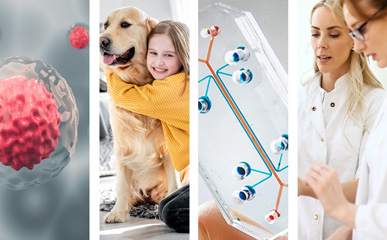Pro Anima writes to the Euro-Mp to support and to ask for a quick validation of our program VALITOX/Evatox
23 March 2012
19 March 2012
Madame Member
We wish to draw your attention to the report of the European Commission (COM 2011/558 of 13 September 2011 (the Report) which puts back until March 2013 the banning of the use of animals for toxicological tests on cosmetics, at least with respect to acute toxicity.
The reason given is that the Commission limits itself to “confirmed progress” and anticipates that decisive “end points” – cellular test procedures – will not be available within the planned time frame. However this assertion can be challenged.
For example, the Pro Anima scientific committee is well known for its work in promoting viable chemical methods that eliminate animal experimentation. Pro Anima has enlisted the support of many animal protection groups* in the VALITOX programme that has led to the invention of an innovative technique known as “DAP”(patent held by NOVALEADS); the technique is already on the market as an in vitro test called EvaTOX and is already being widely used (for unregulated cosmetics ; transportation of toxic substances ; work on heavy metals, fungicides, and some anti-carcinogenic properties). All results so far show that EvaTOX is indeed one of the “end points”, and that it is properly effective.
This technique was presented at the 7th World Congress for Alternative Methonds in 2009, and again at a LRC workshop at Stresa in June 2010 ; evidence of its viability. A request for pre-validation was filed with the ECVAM on 15 April 2011, a filing acknowledged under the reference “réponse 18 (ARES 2011) n° 43 03 73”. Since then we have heard nothing : ECVAM remains silent. The Report makes no mention of our filing (even though it does mention an older method, now being re-evaluated, to discern substances with a DL50 above 2000mg/kg, something the DAP technique does with ease).
We should remember that the Commission introduced the idea of validation in order to allow the industry to develop alternative methods, meanwhile postponing the banning of animal testing. On what grounds are they claiming that satisfactory tests won’t be available in 2013, when they know perfectly well that they already exist ? Could it just be the result of a bottleneck at the ECVAM ? In our view that could never be an excuse for justifying further delay in 2011 to an outcome promised as far back as 2003 !
We would really appreciate your intervention in getting the authorities to take the necessary steps to force ECVAM to get the DAP test procedure into the validation pipeline without further delay, making it part of its priority to stick to the 2013 deadline for the prohibition of animal testing, at least for acute toxicity. And this is possible if they get on with it in an efficient manner ; let’s hope that the Commission will see this as a point of honour.
If it were genuinely too late, it would be necessary to intervene to get the Commission to give up its dogmatic position of denial that is, in our view, the real cause of the delay.
Can we hope for the publication of the necessary conditions that alternative methods must satisfy in order to be accepted as of right, with other methods being submitted to the normal ECVAM process (equivalent to ‘category exemptions’ common in anti-trust law)? The prohibition of animal testing would follow automatically when at least one validated test gets to market for each type of toxicity. It’s worth remembering that the users of such tests are competent professionals, closely in touch with human health issues, competent to make such choices themselves.
There’s more at stake than the number of mice used in cosmetic testing, which in any case is not that many. Inaccurate reports of the total numbers of animals used, with hazy future projections, would send a very negative message of impotence in our struggle to reduce the number of animals that come under the REACH programme which is, as we know, quite “consumer” focussed. In any case we also know that reduction in animal usage is proportional to the political determination to stop using animals.
Until the Commission gets grip on this issue, not only will animals continue to suffer, but so will the scientific and industrial investments now being made. The legislation should be positively encouraging alternative methods ; we already know that animal results are not transferable to humans and that in vitro tests cost a lot less than animal testing. A more decisive official posture would stimulate investment in scientific and social progress – we still have much to learn about the human cell – an investment in future skilled employment.
The report suggests that the Commission is currently carrying out an evaluation of the situation and an impact analysis, and we respect the responsibility of that initiative. We hope to bring to that evaluation useful information for the Commission’s consideration, contributing we hope to a more efficient, courageous maybe even progressive
decision … We fully understand that this involves a wholesale change of old methods and procedures, but this has already been achieved elsewhere.
Thank you for your attention, Madame Member. We send you our sincere good wishes.
* SNDA, SPA, Association Bourdon, Fondation 30 millions d’amis, Fondation Brigitte Bardot, LFCV, LSCV.


